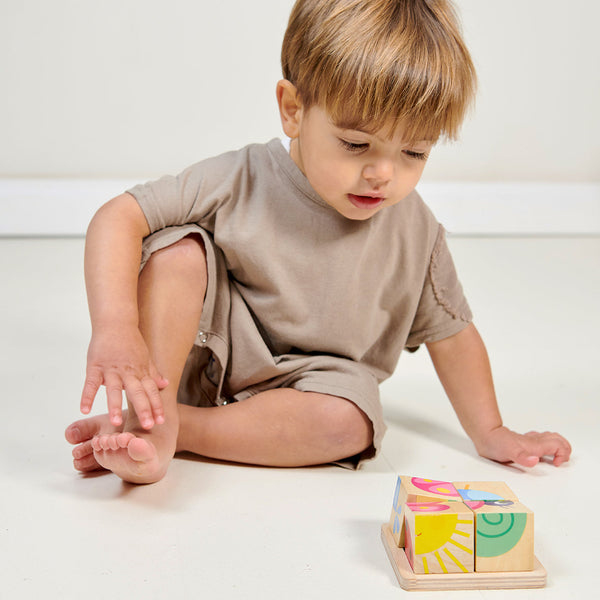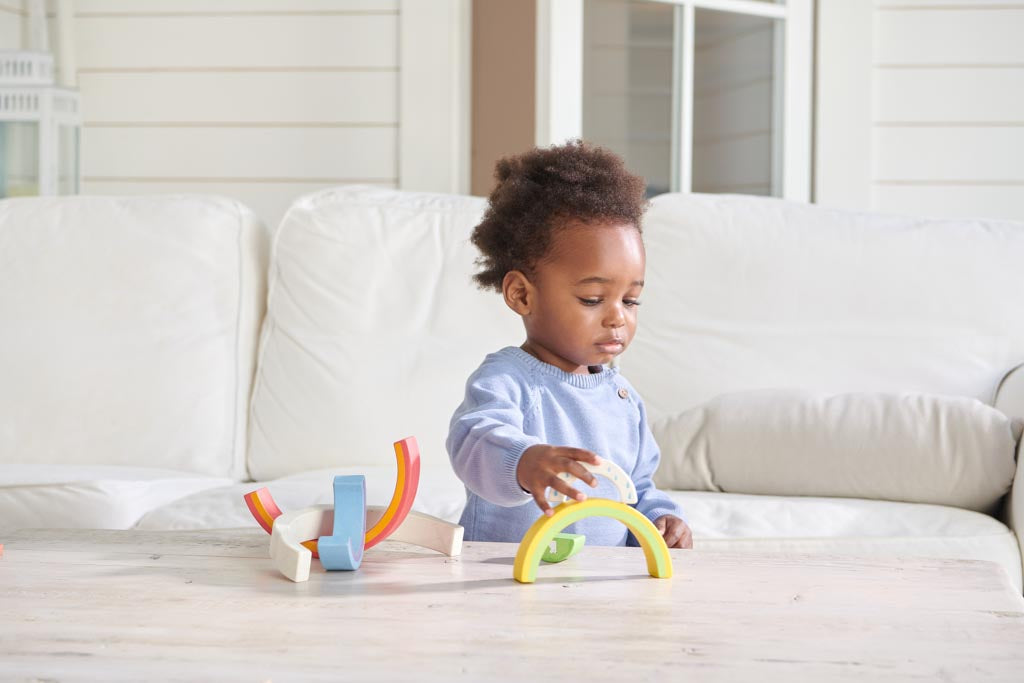Buying toys for your Toddler

Choosing a toy for a toddler is easy.
Go to your local toy shop. Look for the noisiest, most garishly-coloured plastic tat you can find. Does it have flashing lights? Great. A motor? Even better.
It’s sure to be a hit - for 24 hours.
But it soon lies forgotten in a corner of the playroom while your child gets weeks of fun out of the box it came in.
Why?
Because choosing the right toy for a toddler is hard.
What would he like for Christmas? people would ask when my eldest son was two.
He likes Thomas the Tank Engine, doesn’t he?
Well, yes, he did, but that wasn’t the point.
He loved his train set. But he couldn’t have cared less if the trains were branded. His play was driven by his desire to explore concepts like inside, outside, through, forwards, backwards, along, next to, between and around.
That may sound simple, but it’s the work of many years. These concepts are the building blocks of the schemas that power toddlers’ play.
How to choose the right toy for your toddler
There are two things to consider when choosing a toy for a toddler:
- Is it developmentally appropriate?
- Is it open-ended?
Developmentally appropriate toys for toddlers
The best toddler activities focus on heuristic play - that is investigations into the properties and functions of materials.
What happens when I roll this ball?
Where does the car go when I drop it behind the sofa?
If I strike the doll’s house with this toy hammer, will it break?
Towards the end of the toddler years, play becomes symbolic: one thing stands in for another. The sink is a lake, this toothbrush is a boy, the toothpaste is a crocodile.
This gift guide focuses on how we guide our children from that early phase of exploration and discovery to the high-point of preschooler activities - imaginative play.
What are open-ended toys?
How many ways can you think of to play with a puzzle? Unless you get really left-field and start posting the pieces or stacking them, there’s really only one way to do it. Wooden blocks, in contrast, can be used to build towers, of course, but they can also build tunnels, houses and castles. Even better, they can be sausages frying in your play kitchen or sticks of dynamite placed under the enemy’s bridge. They are open-ended.
Now that we know the progression is from turning over objects in our hands to turning them over in our minds, we can look at the toys that will help us along the way:
Here’s our list of the best toys for toddlers:
- Wooden animals
- Wooden blocks
- Nested toys
- Vehicles
- Stacking toys
- Puzzles
- Walkers and ride-ons
- Baskets and bags
Toddlerdom may only span two years, from 12 to 36 months, but it’s a wide range, developmentally.
So let’s take a look at toys by year.
Toys for 1-year-olds
From crawling to walking, from babbling to speech, the transition from baby to toddler is marked. Movements become smoother and more co-ordinated: piling, stacking, placing, posting and transporting. These are the themes of your child’s second year. And that means simple toys with lots of potential for discovery.
Hammering games
A classic toddler activity, but what is the point? Why do young children love hammering?
It’s all to do with the up/down striking motion. They are developing their hand-eye co-ordination, learning to hitdf a target but, more importantly, learning to move with control. These vertical movements eventually become the ascenders and descenders of letter formation.
See the Woodpecker Hammering Game.
Wooden animals and arks
On the farm, in the woods, the jungle, the sea - or even back into prehistory, wooden animal figures are a toy box staple.
As we saw above, from around the age of two, children begin to play symbolically.
This wooden tiger stands in for a real one. This cardboard box is his enclosure at the zoo.
However, one-year-olds play with objects in much more straightforward ways. In, out, in front of and behind. These movements are eventually combined to tell stories as part of smallworld play, but, for now, a wooden animal is their best friend in pocket-sized form. It is something to carry and place, post and retrieve.
This is why a shape-sorter ark is such a firm favourite at this age. It combines all the heuristic fun of containers with the small world play potential of wooden animal figures.
Blocks
A first set of wooden blocks needn’t be complicated. Older children need a range of pieces to arrange and construct but younger toddlers are still working out how to pick up and place with precision. A simple stack of two or three blocks is an engaging and deeply satisfying activity.
Baskets and trolleys
Moving things from A to B is an obsession for toddlers. They are exploring the idea of transporting, one of several play schemas,, or mental models, of how things work that drive much of a young child’s play.
Baskets, bags, pull-along carts and push-along trolleys all serve the same function - to carry. Or you can even use your hands or pockets. The point is to move.
Toddlers even enjoy moving themselves and you’ll often see them happily engaged in simple games of back and forth. It’s one of the reasons they love being pulled along on a scooter or pushed across the garden in a wheelbarrow.
Any toy that satisfies this urge is sure to be a hit.
Walkers, ride-ons and rocking horses
Taking your first steps is a thrill. But it can be hard work. And for a year or so, a bit of extra support is welcome. This is the age of the walker. It's fun to cross the room, safe in the knowledge that you won't trip or fall. And, best of all, you are transporting all of your favourite toys at the same time.
Recommended toys
Activity walker or block walker
For a slightly older toddler, a pram fulfils the same role.
As children's balance improves, they can start to walk independently before eventually trying a ride-on or rocking horse.
Developing a good sense of balance is not only important for gross motor movements. Surprisingly, it's also crucial for reading. Our vestibular system, which is responsible for our balance, also helps to keep the eyes level as they follow words across the page.
Stacking
Babies spend much of their time trying to co-ordinate their limbs. They are concerned with whole-body movements like swinging arms and kicking legs. But by the time they become toddlers, these actions have come under control and the focus switches to moving with precision.
And what better way to move precisely than to place a ring on a stacker?
When you are 12 months old, it’s a challenge!
Just getting the ring onto the post is tricky. Adding the rings in order (and the right way up!) is the work of many months.
See also: animal stackers, garden animals, forest creatures and sea creatures.

Toys for 2-year-olds
By the time of their second birthday, children have learnt to walk and talk. And they are familiar with the properties and possibilities of many common materials. They know that blocks stack and that wheels roll.
Now is the time to combine that knowledge in new ways to make further learning possible. It’s also the dawn of imaginative play. A peg doll is no longer just an object to post into holes or hammer against walls. It is the man who drives the bus, a mother walking to the shops or a child climbing the stairs.
Toys for 2-year-olds should continue to be simple and open-ended. What changes is that your child plays with them in more sophisticated ways.
Dolls
Babies appreciate the reassuring presence of a familiar soft toy but the play doesn’t go very far. Dolls are something to hug or handle. But toddlers breathe life into their toys. A doll is someone to bring along, to transport and to talk to.
If you are looking for a beautiful hand finished soft toy or rag doll, then please hop over to our sister company ThreadBear Design
Nested toys
Nested toys, such as rainbow stackers, are didactic, which means that they ‘teach’.
Your child learns that things go in order, from smallest to largest, simply by playing with the toy. If you put the pieces in the wrong order, they either don’t fit or leave too big a gap. It’s clear what went wrong and what you have to do to correct it.
Babies learn that some objects fit into holes but not others. They are developing an understanding of big and small. Next comes the need to put three objects in order: small, medium and large; big, bigger, biggest. Think the Three Bears' porridge bowls or chairs.
Didactic materials are a powerful learning aid because there is no need for an adult to be on hand to instruct. The learning happens through independent play.
And once you have understood this type of play, you see that numbers work in the same way. 1, 2, 3, 4, 5... The order is fixed. 3 never comes before 2. This is called seriation and it’s the basis of counting.
Recommedations:
Rainbow tunnel | Mountain pass | Forest tunnels
Puzzles
After everything we have said about the benefits of open-ended play it may seem strange to recommend puzzles.
They can only be completed in one way. They have no play possibilities.
But they have a secret weapon - spatial reasoning. Learning to orientate objects is key to successful reading and writing once school starts. If you can’t see the difference between a ‘b’ and a ‘d’, or how to rotate a ‘6’ to get a ‘9’,
Babies take puzzle pieces and simply try to fit them into holes but toddlers are more sophisticated. They turn and reposition, trying one way and then the other. Best of all, they eventually learn to turn the objects in their minds, without having to having to rotate the actual piece. They can tell if it will fit.
Vehicles
Why do toddlers love vehicles so much?
Movement is fun, of course, and that explains some of the appeal, but it’s not the whole story.
Young children are learning to make sense of the world and there are certain key concepts that help: trajectory, going back and forth, crossing a boundary, going in and out and going around, for example. These schemas are the building blocks of later learning and they all get tested to destruction in vehicle play.
Take another look at vehicle play. It's every bit as educational as some seemingly worthier activities - and great fun!
Final word
What are the best toys for toddlers? The ones they will actually play with.
It’s tempting to go for the flashing lights and the plastic but deeper, more meaningful play only comes from open-ended toys.
These come with the added bonus that their appeal only increases over time. As your child grows, so too does the challenge - and the fun.
By Alexis Ralphs for ThreadBear Design
Table of contents
- How to choose the right toy for your toddler
- Developmentally appropriate toys for toddlers
- Toys for 1-year-olds
- Hammering games
- Wooden animals and arks
- Blocks
- Baskets and trolleys
- Walkers, ride-ons and rocking horses
- Developmentally appropriate toys for toddlers
- Stacking
- Toys for 2-year-olds
- Dolls
- Nested toys
- Developmentally appropriate toys for toddlers
- Puzzles
- Vehicles
- Final word















